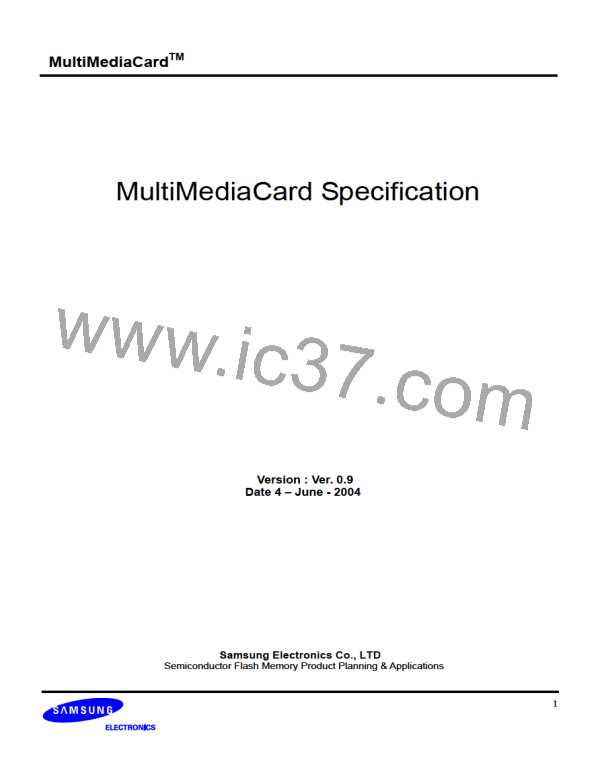MultiMediaCardTM
Unlike the MultiMediaCard protocol (where the register contents are sent as a command response),
reading the contents of the CSD and CID registers in SPI mode is a simple read-block transaction. The
card will respond with a standard response token (refer to Figure “Read Operation”) followed by a data
block of 16 bytes suffixed with a 16 bit CRC. The data timeout for the CSD command cannot be set to
the card TAAC since this value is stored in the CSD. Therefore the standard response timeout value
(NCR ) is used for read latency of the CSD register
4.10.7 Reset Sequence
The MultiMediaCard requires a defined reset sequence. After power on reset or CMD0 (software reset)
the card enters an idle state. At this state the only legal host command is CMD1 (SEND_OP_COND)
and CMD58 (READ_OCR). In SPI mode, as opposed to MultiMediaCard mode, CMD1 has no
operands and does not return the contents of the OCR register. Instead, the host may use CMD58
(available in SPI mode only) to read the OCR register. Furthermore, it is in the responsibility of the host
to refrain from accessing cards that do not support its voltage range. The usage of CMD58 is not
restricted to the initializing phase only, but can be issued at any time. The host must poll the card (by
repeatedly sending CMD1) until the in-idle-state’ bit in the card response indicates (by being set to 0)
that the card completed its initialization processes and is ready for the next command. The host must
poll the card (by repeatedly sending CMD1) until the ‘in-idle-state’ bit in the card response indicates (by
being set to 0) that the card completed its initialization processes and is ready for the next command.
4.10.8 Error Conditions
Unlike the MultiMediaCard protocol, in the SPI mode the card will always respond to a command. The
response indicates acceptance or rejection of the command. A command may be rejected if it is not
supported (illegal opcode), if the CRC check failed, if it contained an illegal operand, or if it was out of
sequence during an erase sequence.
4.10.9 Memory Array Partitioning
Same as for MultiMediaCard mode.
4.10.10 Card Lock/Unlock
Usage of card lock and unlock commands in SPI mode is identical to MultiMediaCard mode. In both
cases the command response is of type R1b. After the busy signal clears, the host should obtain the
result of the operation by issuing a GET_STATUS command. Please refer to Chapter “Card
lock/unlock operation” for details.
4.10.11 Commands
All the MultiMediaCard commands are 6 bytes long. The command transmission always starts with the
left bit of the bitstring corresponding to the command codeword. All commands are protected by a CRC.
The commands and arguments are listed in Table
Table 4-14 Command bit position
Bit position
Width (bits)
Value
[47]
1
‘0’
[46]
1
‘1’
[45:40]
6
×
[39:8]
32
×
[7:1]
7
×
[0]
1
‘1’
end bit
Description
start bit
transmission bit
command index
argument CRC7
53

 SAMSUNG [ SAMSUNG ]
SAMSUNG [ SAMSUNG ]